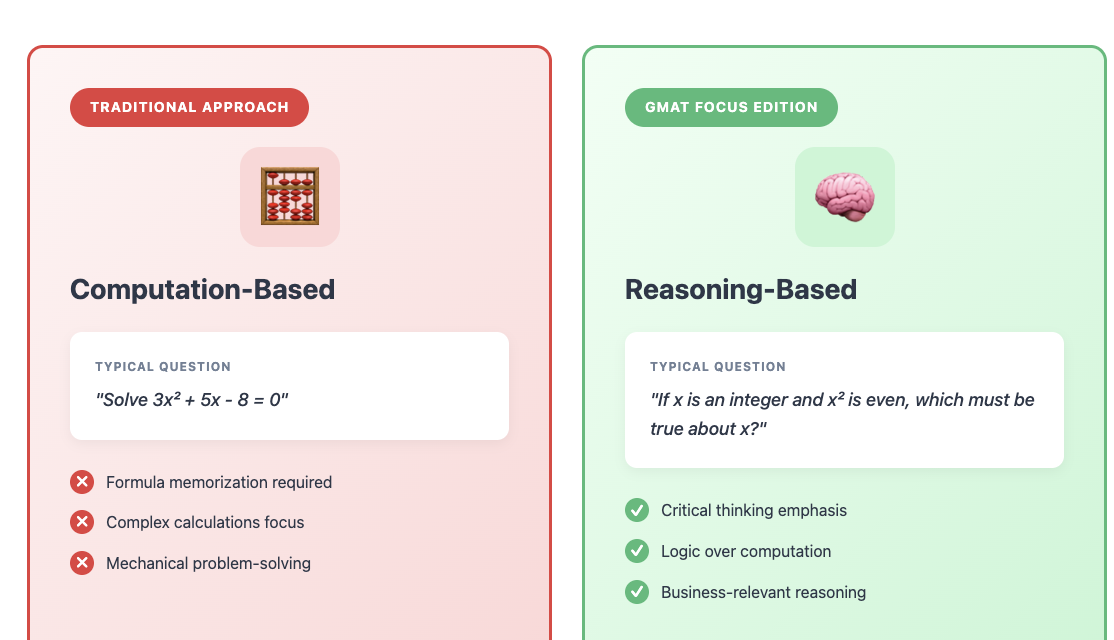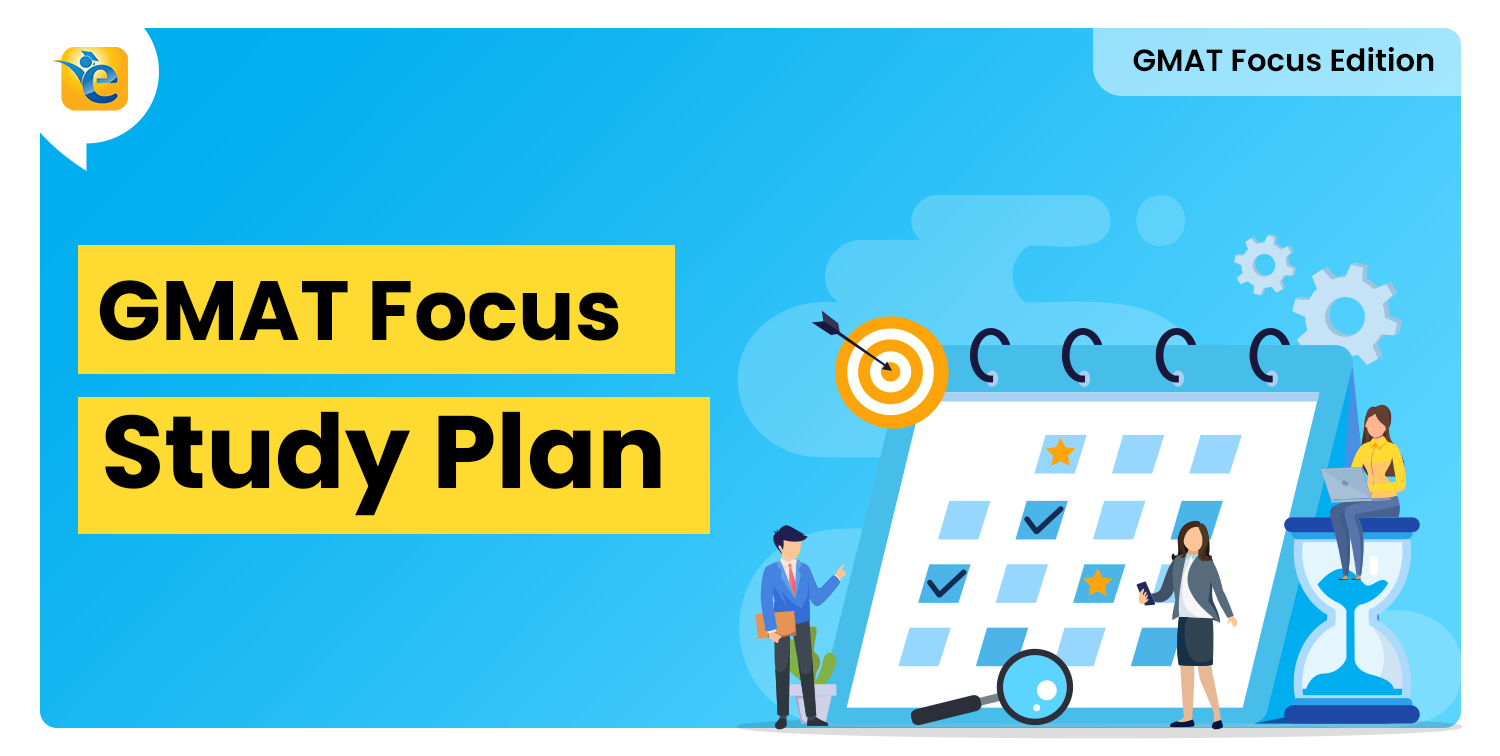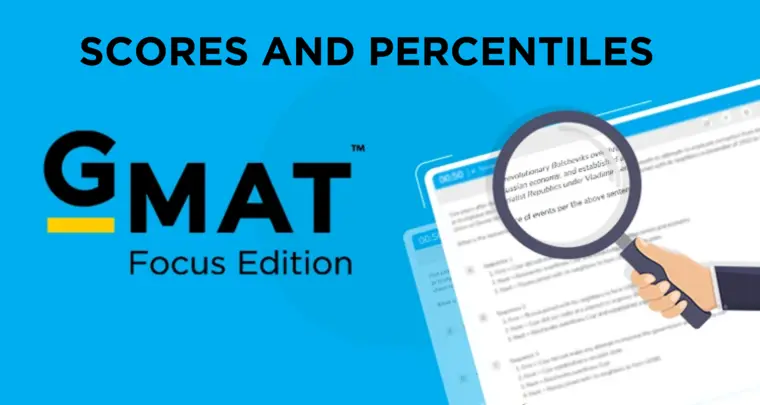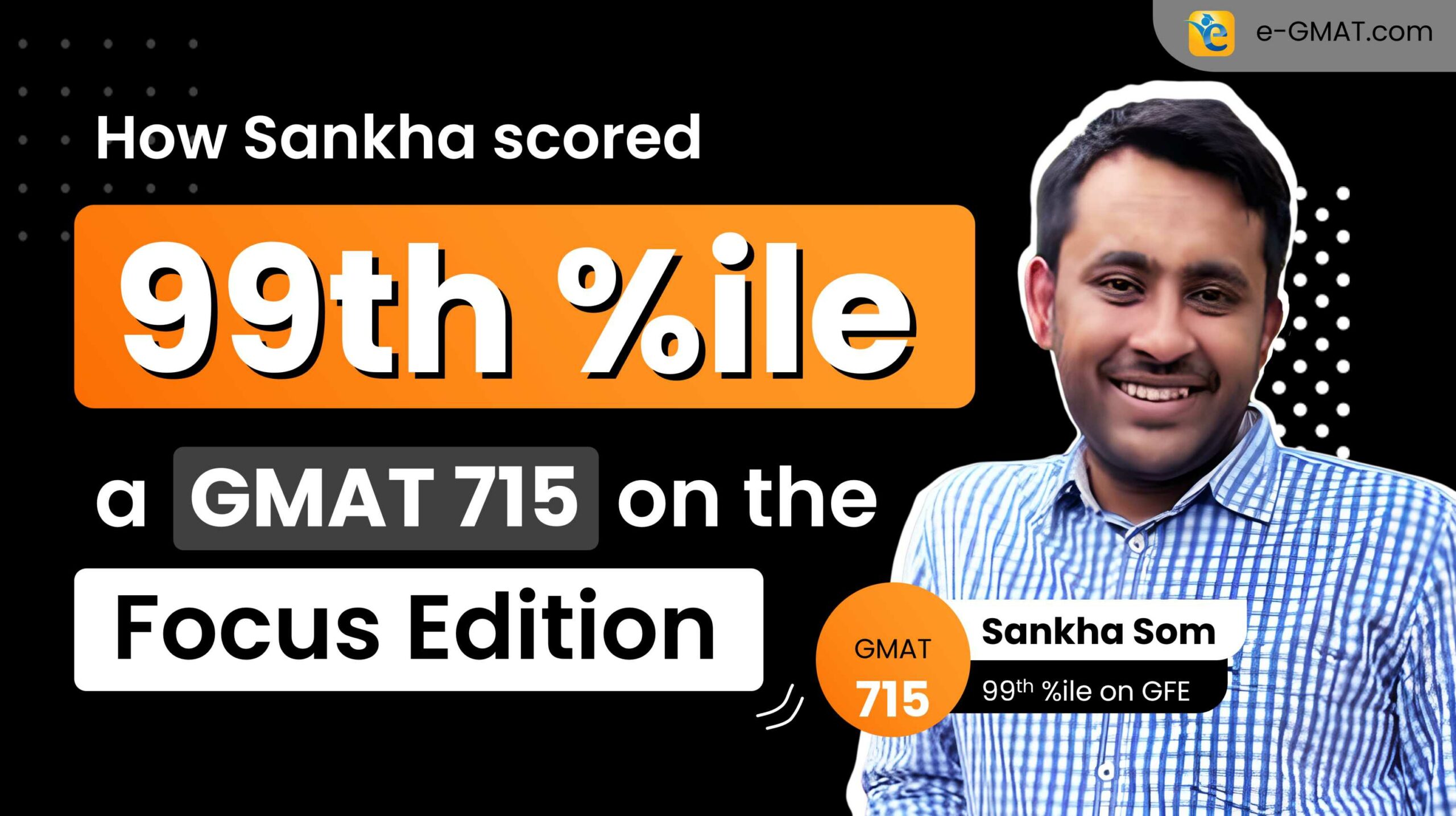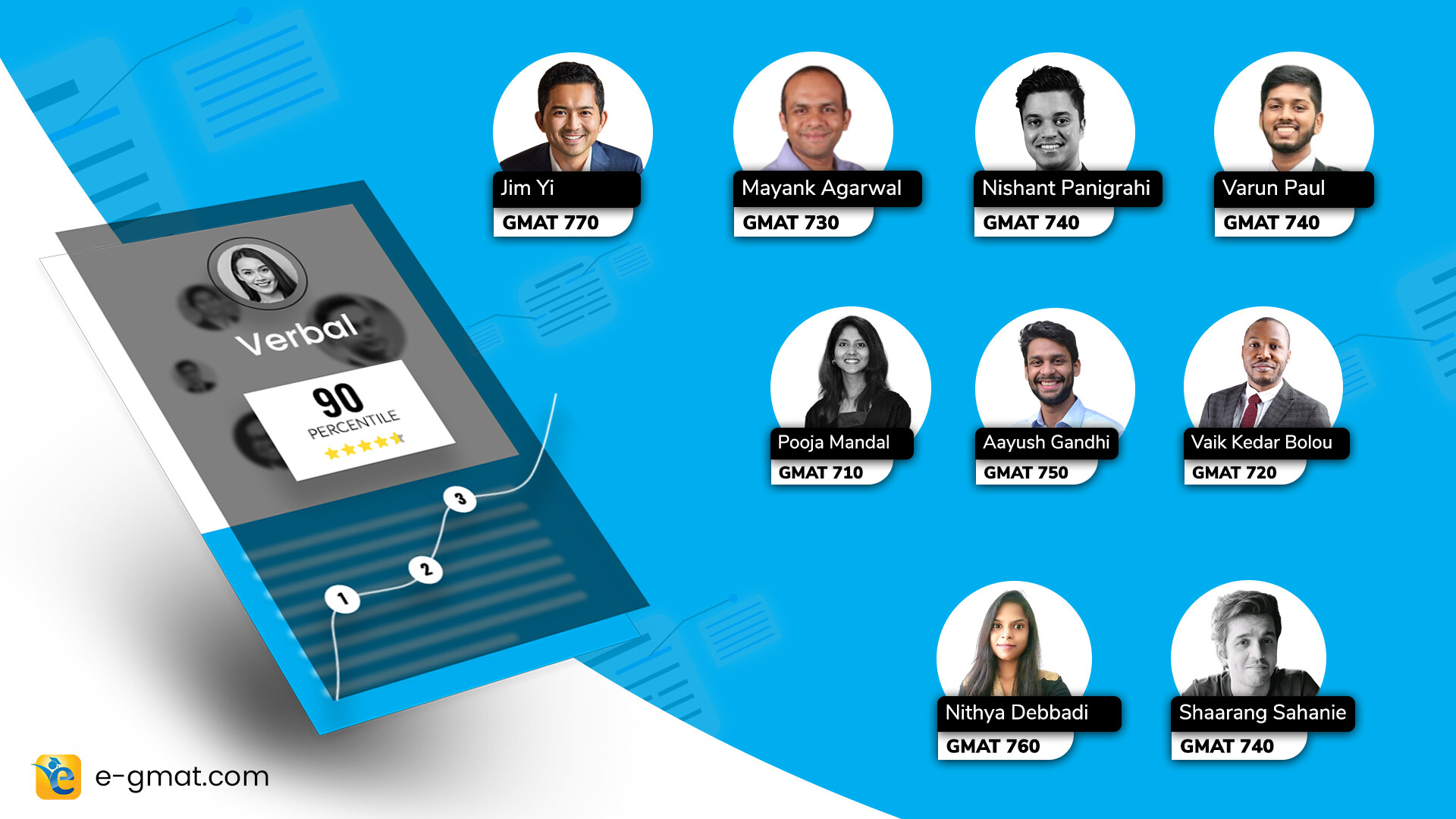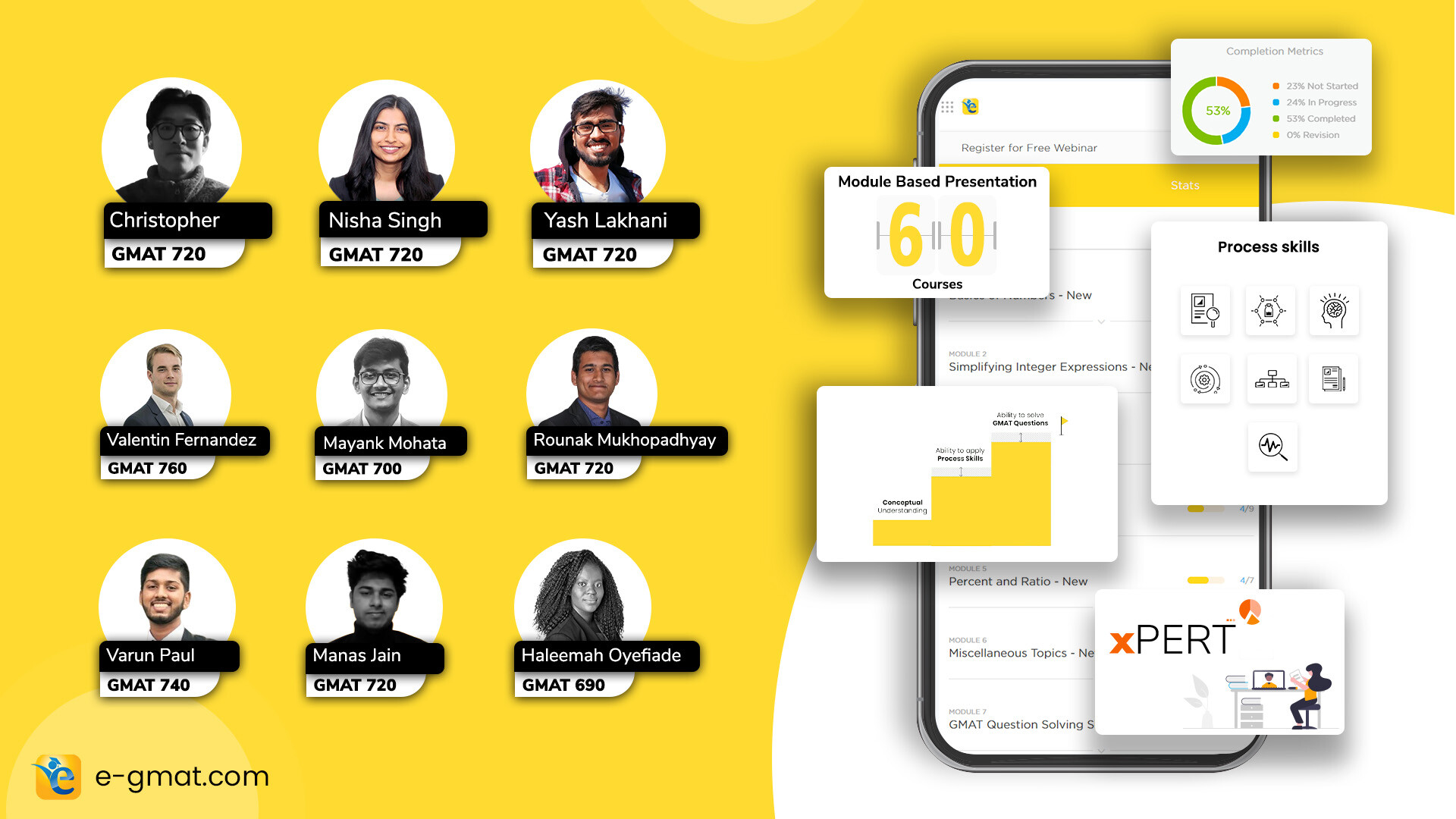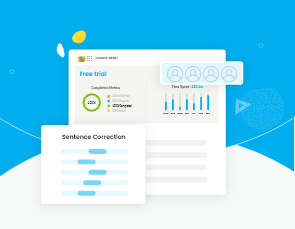The GMAT Quantitative Reasoning section on the Focus Edition consists of 21 Problem Solving questions covering arithmetic and algebra topics from high school math—with no calculator allowed and 45 minutes to complete. This streamlined format removes Data Sufficiency questions entirely from Quant (they’re now in Data Insights) and eliminates complex geometry, making your preparation more focused and efficient.
To master this section, we’ve developed a proven three-stage methodology: Learning Concepts, Cementing Methods, and Building Expertise. This structured progression ensures you build skills systematically rather than randomly practicing questions.
From 695 to Perfect 90s Across All Sections
“The three-stage approach completely transformed my GMAT journey. I went from 695 to 805 – achieving perfect 90s across all sections. The key was following the personalized study plan that mapped my entire journey from start to finish.”
[Video highlights include:]
- How the structured progression prevented knowledge gaps
- Why sectional mocks were crucial for maintaining skills across all three sections
- The importance of trusting the process even when progress felt slow
- Specific examples of how each stage built upon the previous one
Shrutav’s remarkable transformation validates why structured methodology beats random practice. His systematic progression through learning fundamentals, cementing with targeted practice, and building expertise with advanced problems created the foundation for his exceptional score.
This comprehensive guide breaks down exactly what mathematical concepts you need to master, which topics appear most frequently, and how to create an effective study plan. You’ll discover why the “2 minutes per question” rule is harmful, learn the strategic timing methods used by 90th percentile scorers, and get actionable steps to start your preparation this week.
⭐ TL;DR Summary:
- 21 Problem Solving questions in 45 minutes (no Data Sufficiency in Quant anymore)
- No calculator allowed—mental math and estimation skills are essential
- 75-80% of questions come from Arithmetic and Algebra fundamentals
- Geometry is largely removed from Quant (no coordinate geometry, complex shapes)
- Strategic timing beats rigid rules—top scorers spend 1-3 minutes per question based on difficulty
- Score range: 60-90—contributes equally to your Total GMAT Score (205-805)
- What Exactly Is Tested in GMAT Quantitative Reasoning Section?
- What Topics Are Covered in GMAT Quantitative Reasoning Syllabus?
- How Should I Prioritize GMAT Quant Topics for Maximum Score Impact?
- How Does the “Takt Time” Method Improve GMAT Quant Pacing?
- What Are the First Steps to Start GMAT Quant Preparation?
- Your GMAT Quant Preparation Checklist
What Exactly Is Tested in GMAT Quantitative Reasoning Section?
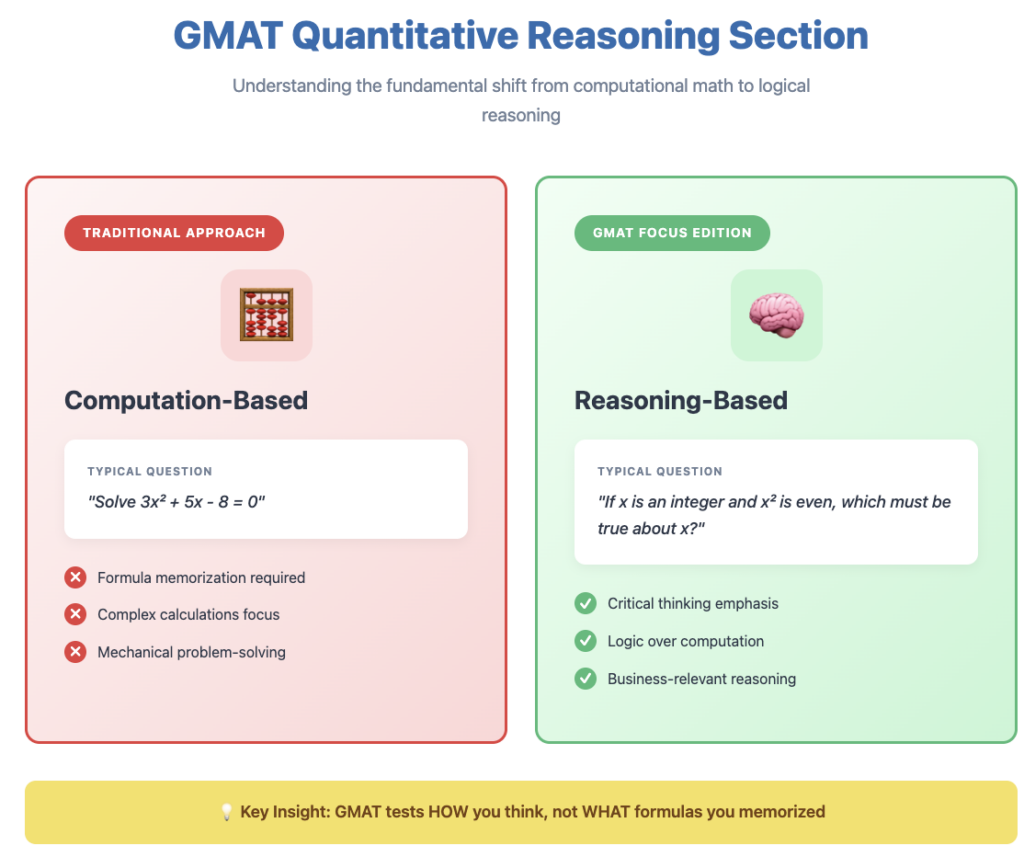
The GMAT Quantitative Reasoning section tests your logical reasoning and problem-solving abilities using high school-level arithmetic and algebra, without requiring any advanced mathematics like calculus or trigonometry. The exam deliberately uses simple math concepts to assess how you think through problems, not your computational abilities.

What’s the Format of the GMAT Quant Section in 45 Minutes?
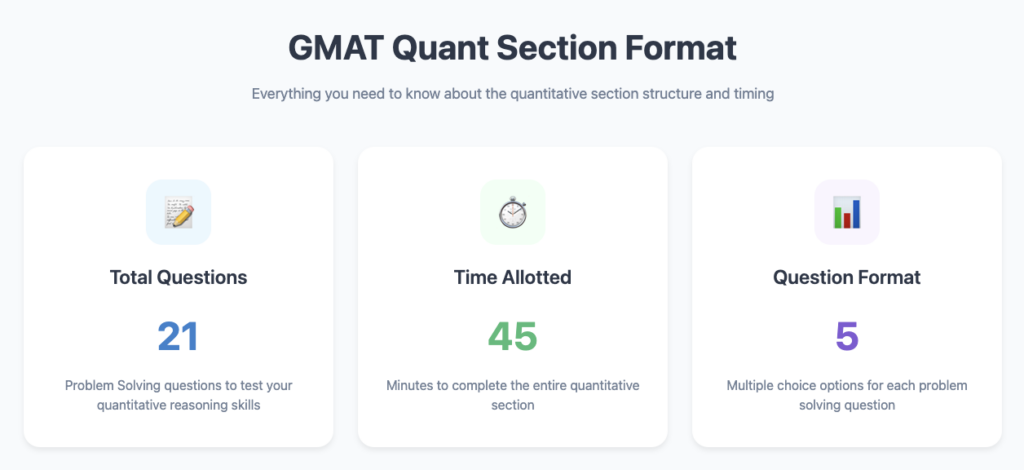
⚡ Quick Answer: You’ll face 21 Problem Solving multiple-choice questions in 45 minutes, with no calculator permitted and all questions having five answer options.
Here’s the complete breakdown of what to expect:
ℹ️ GMAT Quant Format Overview
| Component | Details |
| Total Questions | 21 (all Problem Solving) |
| Time Limit | 45 minutes |
| Average Time per Question | 2 minutes 9 seconds |
| Question Type | Multiple choice (5 options) |
| Calculator | Not allowed |
| Score Range | 60-90 |
| Contribution to Total Score | Equal weight with Verbal and Data Insights |
Important Update: Data Sufficiency questions have been completely removed from the Quantitative section in the Focus Edition. They now appear exclusively in the Data Insights section.
↗️ Score Comparison: Focus Edition vs Old GMA
The scoring scale has also changed significantly
The official administrator of the GMAT Exam, Graduate Management Admissions Council (GMAC) notes, “Because the GMAT Exam (Focus Edition) Total Score scale AND score scale distribution are different from the GMAT Exam (10th Edition), comparing total scores or section scores from the previous version of the exam to the current edition of the GMAT is not appropriate, accurate, or a meaningful comparison of performance.
If your relative competitiveness based on the GMAT Exam (Focus Edition) needs to be compared to the GMAT Exam (10th Edition), it is more appropriate to compare percentile rankings rather than comparing total scores”
↗️ Score Comparison: Focus Edition vs Old GMAT
| Focus Edition Score | Old GMAT Equivalent | Percentile (Approx.) |
| 89 | 51 | 97th percentile |
| 89 | 50 | 95th percentile |
| 85 | 49 | 85th percentile |
| 82 | 48 | 75th percentile |
Source: GMAC Official Score Concordance (2024)
What Mathematical Skills Does GMAT Quant Really Test?

⚡ Quick Answer: GMAT Quant tests reasoning and logic using basic math as the medium—it’s about how you think, not what formulas you memorize.
The official GMAC description explicitly states that success “relies on logic and analytical skills, not the underlying math skills.” Here’s what this means in practice:
Instead of pure math questions like: “Solve 3x² + 5x – 8 = 0”
You’ll see reasoning questions like: “If x is an integer and x² is even, which of the following must be true about x?”
The second question tests your understanding of number properties and logical deduction, not just formula application.
This distinction between reasoning and computation isn’t just theoretical—it’s something successful test-takers experience firsthand: “Coming from CAT preparation, I was used to selective problem-solving. But GMAT demanded a complete shift in mindset. I had to develop an intuitive approach where I’d first write ‘find X’ before solving any problem. This simple habit of careful reading and strategic marking helped me see patterns rather than just compute answers. The key was understanding that GMAT tests how you think through problems, not whether you remember formulas.”
⭐ Expert Insight
The GMAT Focus Edition was designed with input from 65+ top business schools and tested on 5,400+ candidates. This ensures the skills tested—critical thinking, data analysis, and problem-solving—directly align with what MBA programs value.
Since no calculator is allowed, you’ll need strong:
- Mental math skills (multiplication tables up to 15×15)
- Estimation abilities (recognizing 24% of 198 ≈ 25% of 200 = 50)
- Number sense (fraction-decimal-percent conversions)
Real-world relevance: These skills mirror business decision-making. As a marketing manager, you won’t solve quadratic equations, but you will analyze whether sales trends are significant—exactly the type of critical thinking GMAT Quant demands.
What Topics Are Covered in GMAT Quantitative Reasoning Syllabus?
The GMAT Quant syllabus consists entirely of high school-level arithmetic and algebra topics, with geometry almost completely removed from the Focus Edition. You won’t encounter trigonometry, calculus, or any college-level mathematics.
What Arithmetic Topics Should I Study for GMAT Quant?

⚡ Quick Answer: Arithmetic forms the foundation of GMAT Quant, covering number properties, fractions, percentages, ratios, basic statistics, and counting methods—expect about 40% of your questions from these topics.
Here’s the complete breakdown of arithmetic topics:
ℹ️ Complete Arithmetic Topics Checklist
1. Number Properties & Integers
- ✅ Positive/negative number rules
- ✅ Odd/even properties
- ✅ Prime and composite numbers
- ✅ Divisibility rules (2, 3, 4, 5, 6, 9, 10)
- ✅ Remainders and modular arithmetic
- ✅ Factors and multiples
- ✅ Greatest Common Factor (GCF)
- ✅ Least Common Multiple (LCM)
- ✅ Properties of consecutive integers
2. Fractions, Decimals, and Percentages
- ✅ Converting between forms
- ✅ Operations with fractions
- ✅ Percentage increase/decrease
- ✅ Compound percentages
- ✅ Common conversions (e.g., 1/8 = 0.125 = 12.5%)
3. Ratios, Proportions, and Variation
- ✅ Setting up proportions
- ✅ Scaling problems
- ✅ Direct variation (y = kx)
- ✅ Inverse variation (y = k/x)
- ✅ Mixture problems
4. Powers, Exponents, and Roots
- ✅ Laws of exponents
- ✅ Negative and fractional exponents
- ✅ Square and cube roots
- ✅ Units digit patterns
- ✅ Scientific notation
5. Basic Statistics
- ✅ Mean, median, mode
- ✅ Range
- ✅ Standard deviation (conceptual only)
- ✅ Weighted averages
6. Sets and Venn Diagrams
- ✅ Union and intersection
- ✅ Two-set formula: |A ∪ B| = |A| + |B| – |A ∩ B|
- ✅ Three-set problems
- ✅ “Neither” calculations
7. Basic Probability
- ✅ Simple probability (favorable/total)
- ✅ Independent events
- ✅ Mutually exclusive events
- ✅ Complement rule
8. Counting (Combinatorics)
- ✅ Fundamental counting principle
- ✅ Permutations (order matters)
- ✅ Combinations (order doesn’t matter)
- ✅ Arrangements with repetition
⚠️ Common Pitfall
Number Properties is the most overlooked topic, even by engineers. Questions like “If n² is divisible by 72, what is the largest positive integer that must divide n?” require understanding prime factorization deeply, not just knowing the concept exists.
What Algebra Topics Are Required for GMAT Quant?
⚡ Quick Answer: Algebra on the GMAT covers equations, inequalities, quadratics, and basic functions—all at high school level, representing about 35% of questions.
ℹ️ Complete Algebra Topics Checklist
1. Linear Equations & Inequalities
- ✅ Solving single-variable equations
- ✅ Setting up equations from word problems
- ✅ Solving for one variable in terms of others
- ✅ Linear inequalities (remember to flip sign when multiplying by negative)
- ✅ Compound inequalities
2. Systems of Equations
- ✅ Two equations, two unknowns
- ✅ Substitution method
- ✅ Elimination method
- ✅ Word problems leading to systems
3. Quadratic Equations
- ✅ Factoring techniques
- ✅ Quadratic formula
- ✅ Perfect square trinomials
- ✅ Difference of squares
- ✅ Understanding the discriminant
4. Algebraic Expressions
- ✅ Simplifying expressions
- ✅ Expanding and factoring
- ✅ Rational expressions
- ✅ Special products: (a±b)² = a² ± 2ab + b²
5. Inequalities & Absolute Values
- ✅ |X| < c means -c < X < c
- ✅ |X| > c means X < -c or X > c
- ✅ Quadratic inequalities
6. Functions and Sequences
- ✅ Function notation f(x)
- ✅ Evaluating functions
- ✅ Simple sequences
- ✅ Symbol functions (e.g., p★q = p² – q)
What Other Mathematical Topics Appear on GMAT Quant?
⚡ Quick Answer: Word problems applying arithmetic/algebra concepts, basic statistics, and simple probability round out the syllabus—geometry is essentially eliminated from Quant.
Applied Mathematics (Word Problems)
These aren’t separate topics but applications of arithmetic and algebra:
- Distance/Rate/Time Problems: Using d = rt formula
- Work Problems: Combined work rates (1/T = 1/T₁ + 1/T₂)
- Mixture Problems: Weighted averages and concentrations
- Simple Interest: I = PRT (compound interest rarely tested)
- Profit/Loss: Margins, discounts, markups
⭐ Pro Tip
For word problems, always define variables clearly with “let” statements. This prevents confusion in complex scenarios.
What About Geometry?
Geometry has been almost entirely removed from the GMAT Quant section. You will NOT see:
- ❌ Coordinate geometry (slopes, equations of lines)
- ❌ Complex shapes and angle problems
- ❌ Circle theorems
- ❌ 3D geometry
- ❌ Trigonometry
You might occasionally need:
- ✅ Basic area formulas (rectangle, circle) within word problems
- ✅ Pythagorean theorem for distance calculations
- ✅ Simple perimeter concepts
Topics NOT on the GMAT:
- ❌ Calculus (derivatives, integrals)
- ❌ Trigonometry (sine, cosine, tangent)
- ❌ Complex numbers
- ❌ Logarithms
- ❌ Matrix algebra
- ❌ Any college-level mathematics
How Should I Prioritize GMAT Quant Topics for Maximum Score Impact?
Focus 75-80% of your study time on Arithmetic and Algebra fundamentals, as these topics dominate the test and offer the highest return on investment for score improvement. Within these areas, Number Properties and Linear/Quadratic equations appear most frequently.
Which GMAT Quant Topics Appear Most Frequently?
⚡ Quick Answer: Arithmetic (especially Number Properties) and Algebra (equations and inequalities) make up roughly 75-80% of all questions, while word problems, statistics, and probability comprise the remainder.
ℹ️ GMAT Quant Topic Distribution
| Topic Category | Estimated Frequency | Priority Level |
| Number Properties | 20-25% | Critical |
| Algebra (Equations/Inequalities) | 25-30% | Critical |
| Word Problems | 20-25% | High |
| Fractions/Decimals/Percents | 10-15% | High |
| Statistics/Probability | 10-15% | Medium |
| Other Topics | 5-10% | Low |
Note: These percentages are based on expert analysis of practice tests and may vary slightly
⭐ Strategic Insight
Number Properties is the most overlooked yet critical topic. Even quantitatively strong test-takers often miss these questions because they haven’t reviewed concepts like divisibility rules or remainder properties since high school.
Example of a tricky Number Properties question:
“If n is a positive integer and n² is divisible by 72, what is the largest positive integer that must divide n?”
Solution requires understanding that 72 = 2³ × 3², so n must contain at least 2² × 3¹ = 12.
What Strategic Approaches Work Best for Time-Pressed Professionals?
⚡ Quick Answer: Prioritize logic and estimation over calculation, take an early diagnostic to identify weaknesses, and recognize that different question difficulties deserve different time investments.
Key Strategies for Efficient Preparation:
1. Logic Over Calculation
Many problems can be solved faster through reasoning than computation:
- Use answer choices to your advantage (backsolving)
- Apply number properties to eliminate options
- Look for patterns rather than calculating
Example: “Which could be the units digit of 7ⁿ for positive integer n?”
Instead of calculating, recognize that 7ⁿ cycles through units digits {7,9,3,1}, eliminating other options instantly.
2. Master Estimation
With no calculator allowed, estimation becomes powerful:
- Round numbers for quick calculations
- Use benchmark fractions (1/4 = 25%, 1/3 ≈ 33%)
- Recognize when exact calculation isn’t needed
3. Early Diagnostic Testing
⭐ Action Item
Take an official GMAT Focus practice exam THIS WEEK to establish your baseline and identify specific weaknesses. This prevents wasting time on topics you already know well.
How Does the “Takt Time” Method Improve GMAT Quant Pacing?
⚡ Quick Answer: The Takt Time method recognizes that top scorers strategically vary their time per question based on difficulty, spending 1-3+ minutes as needed rather than forcing every question into 2 minutes.
The Problem with the “2 Minutes Per Question” Rule:
Data from 90th percentile scorers reveals they DON’T follow uniform timing:
⏱️ Actual Timing Patterns: Top Scorers vs Average
| Question Difficulty | Top Scorers (90th %ile) | Average Scorers (50th %ile) |
| Easy Questions | ~1 minute per question | ~1 minute per question |
| Medium Questions | ~1.5 minutes per question | ~1.5 minutes per question |
| Hard Questions | ~2:30-3 minutes per question | ~1:45-2 minutes per question |
Source: e-GMAT platform data analysis (2024)
Real Example: A Q90 scorer’s actual test timing showed:
- 7 questions completed in under 1 minute each
- 7 questions took over 2 minutes each
- Remaining questions around 2 minutes each
Here’s how this flexible timing approach works in practice. Mayank’s 20-day transformation illustrates the power of strategic pacing: “My first attempt rushed me into a 665. Twenty days later, I scored 715. What changed? I stopped racing through questions and started reading thoroughly—especially in RC passages. I used 15+ sectional mocks to identify my timing gaps, then applied a three-step fix: reviewing error logs, practicing official questions, and creating custom quizzes for weak areas. By maintaining this strategic approach daily—never missing more than one day—I learned when to invest time and when to move quickly. The result spoke for itself: a 50-point jump in less than three weeks.”
Mayank’s experience shows how personalized timing strategy creates results. Here’s how to develop your own Takt Time approach:
Developing Your Personal Takt Time:
- Track your timing by topic and difficulty during practice
- Calculate average “correct answer” times for each category
- Identify patterns (e.g., consistently slow on combinations)
- Set personal benchmarks based on your strengths
- Practice flexible pacing in mock tests
⭐ Expert Framework
Think like a Formula 1 driver—you know which track sections allow full speed and which require careful navigation. Your Takt Time is your personal racing strategy.
What Are the First Steps to Start GMAT Quant Preparation?
Begin with a two-pronged diagnostic approach this week: take both an official GMAT practice exam for baseline scoring and a detailed analytics mock to identify specific topic weaknesses. This data-driven start ensures you focus preparation where it matters most.
How Do I Establish My GMAT Quant Baseline Score?
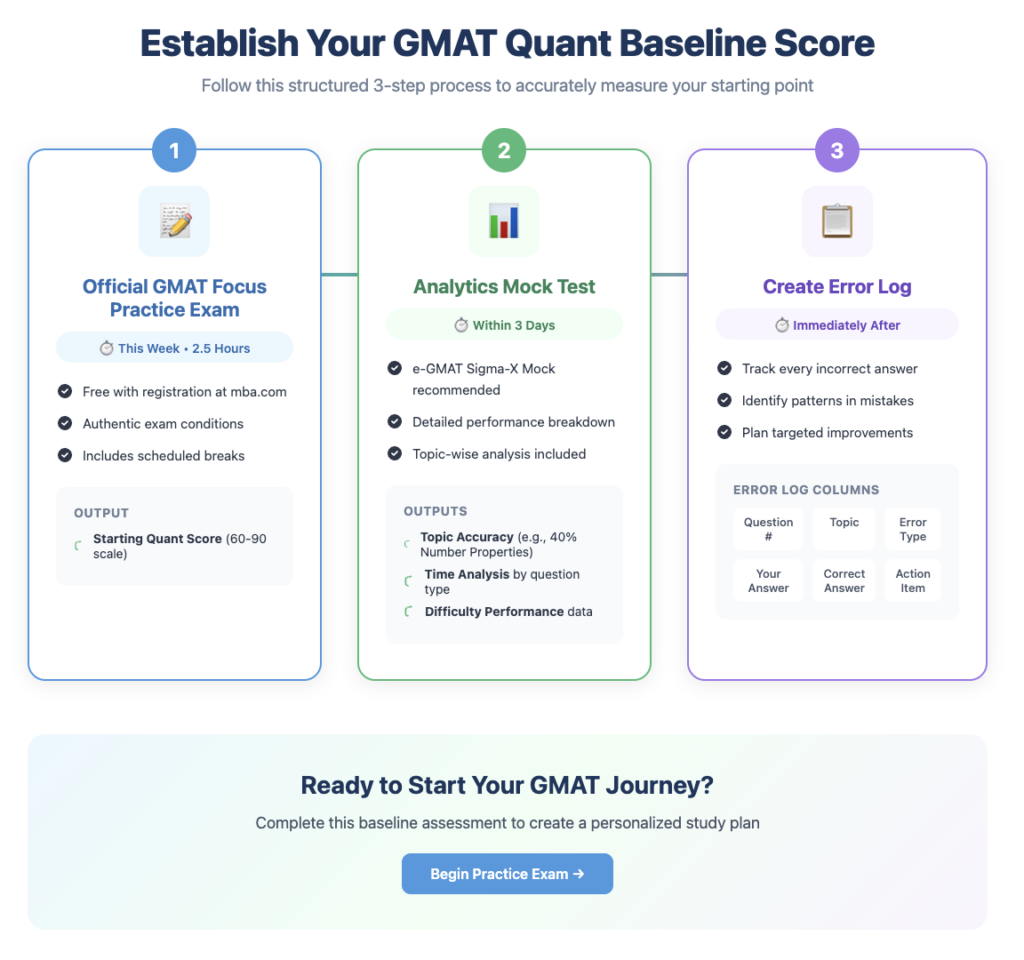
⚡ Quick Answer: Take the free Official GMAT Focus Practice Exam on mba.com for authentic scoring, then supplement with an analytics-rich mock like e-GMAT’s Sigma-X for granular topic-level insights.
Step-by-Step Baseline Process:
1. Official GMAT Focus Practice Exam
- Where: mba.com (free with registration)
- Duration: 2.5 hours including breaks
- Purpose: Authentic baseline score and test experience
- Key Output: Your starting Quant score (60-90 scale)
- Purpose: Detailed performance breakdown by topic
- Key Outputs:
- Accuracy by topic (e.g., 40% on Number Properties)
- Time spent by question type
- Difficulty-level performance
3. Create Your Error Log
⭐ Error Log Template
| Question # | Topic | Error Type | Your Answer | Correct Answer | Action Item |
| Q5 | Number Properties | Concept gap | B | D | Review divisibility rules |
| Q12 | Work Rate | Misread | A | C | Practice careful reading |
| Q18 | Inequality | Time pressure | E | B | Drill inequality rules |
⭐ Pro Tip
Don’t skip the error analysis—it’s the foundation of targeted improvement. Each logged error becomes a specific study task.
How Should I Structure My GMAT Quant Study Schedule?
⚡ Quick Answer: Use your diagnostic data to create a personalized plan allocating 60-80% of time to weak areas, with consistent daily practice sessions rather than weekend cramming.
Two Sample Schedules:
ℹ️ Schedule A: Working Professional (10 hours/week)
| Day | Time | Focus |
| Mon, Wed, Thu | 1 hour each | Concept review + 10 practice questions |
| Tuesday, Friday | 1 hour each | Verbal/Data Insights balance |
| Saturday | 3-hour block | Mock test or deep topic dive |
| Sunday | 2 hours | Review, error log, plan next week |
Total: 80 hours over 8 weeks
ℹ️ Schedule B: Intensive Prep (20 hours/week)
| Day | Time | Focus |
| Mon-Fri | 2-3 hours | Morning: Quant concept, Evening: Practice |
| Saturday | 5 hours | Full mock + detailed review |
| Sunday | 4 hours | Targeted weakness drilling |
Total: 80-100 hours over 4-5 weeks
Key Planning Principles:
- Block calendar time like business meetings
- Balance all three sections (don’t neglect Verbal/DI)
- Adjust focus based on baseline weaknesses
- Include buffer time for review and rest
What Resources Should I Use for Each Stage of GMAT Quant Prep?
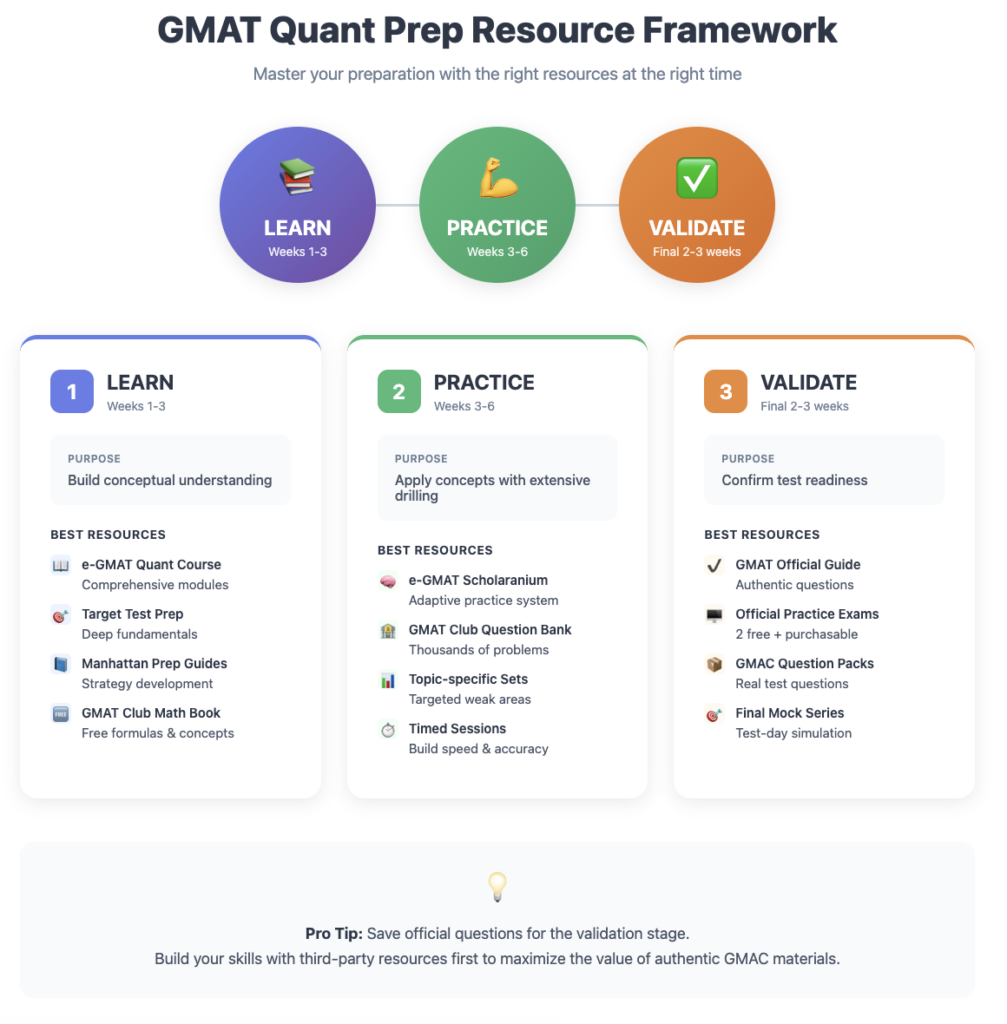
⚡ Quick Answer: Follow the “Learn → Practice → Validate” framework, using different resources optimized for each stage rather than burning through official questions too early.
ℹ️ The Three-Stage Resource Strategy
Stage 1: LEARN (Weeks 1-3)
Purpose: Build conceptual understanding
Best Resources:
- e-GMAT Quant Course (comprehensive modules)
- Target Test Prep (deep fundamentals)
- Manhattan Prep Strategy Guides
- GMAT Club Math Book (free formulas)
Don’t use: Official GMAT questions yet—save these!
Stage 2: PRACTICE (Weeks 3-6)
Purpose: Apply concepts with extensive drilling
Best Resources:
- e-GMAT Scholaranium (adaptive practice)
- GMAT Club Question Bank (thousands of problems)
- Topic-specific problem sets
- Timed practice sessions
Track: Error patterns and timing data
This extensive drilling approach delivers real results. As Kartikey discovered during his preparation: “I built what I called my ‘question database’—exposing myself to thousands of problems. Initially, I used brute force, solving everything I could find. But once I got comfortable, I refined my approach with subjective error analysis, always asking ‘why’ I made each mistake. The key was consistency—daily practice without fail. In the cementing phase, I focused on timed quizzes to develop proper test-taking rhythm. This systematic approach took me from 655 to 705.”
Kartikey’s experience shows why Stage 2 focuses on volume with analysis. The final validation stage requires a different approach…
Stage 3: VALIDATE (Final 2-3 weeks)
Purpose: Confirm test readiness
Best Resources:
- GMAT Official Guide questions
- Official Practice Exams (2 free + purchasable)
- GMAC question packs
- Final mock test series
Focus: Realistic test conditions and final adjustments
⚠️ Common Mistake
Using Official Guide questions while learning concepts wastes your most valuable practice material. These retired real questions should validate your skills, not teach them.
Your GMAT Quant Preparation Checklist
Immediate Actions (This Week):
- ☐ Take Official GMAT Focus Practice Exam for baseline score
- ☐ Take analytics-rich mock (e-GMAT Sigma-X) for topic breakdown
- ☐ Create error log analyzing every missed question
- ☐ Download GMAT Quant syllabus checklist (all topics listed above)
- ☐ Block calendar time for consistent study schedule
Foundation Building (Next 2 Weeks):
- ☐ Master mental math basics (times tables, fraction conversions)
- ☐ Review Number Properties thoroughly (most overlooked topic)
- ☐ Practice 5-minute daily mental math drills
- ☐ Join GMAT Club for free resources and community
- ☐ Gather learning resources (course or guides)
Strategic Development:
- ☐ Track personal Takt Time for different question types
- ☐ Practice estimation techniques on every problem set
- ☐ Identify your “skip” triggers (when to move on)
- ☐ Build topic-specific timing benchmarks
- ☐ Review high-frequency topics first (Arithmetic + Algebra)
⭐ Ready to Start Your GMAT Journey?
Get access to comprehensive GMAT prep resources including detailed video lessons, practice questions, and diagnostic tools to accelerate your preparation.
Remember: The GMAT Quant section tests reasoning through math, not mathematical knowledge itself. Focus on understanding the logic behind problems rather than memorizing formulas, and you’ll be well-prepared for success.


